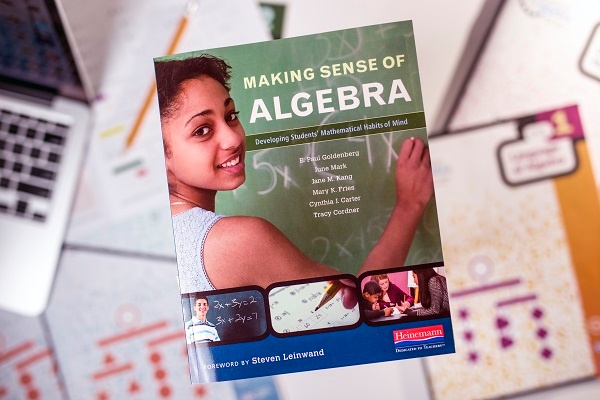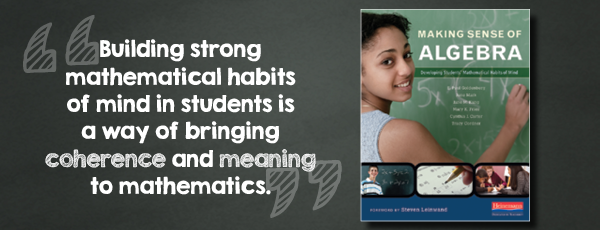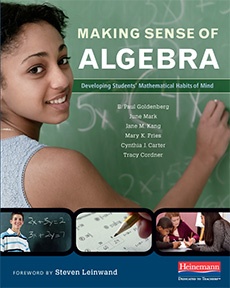
In today’s blog—adapted from the foreword to Making Sense of Algebra—Steven Leinwand, author of Accessible Mathematics, reflects on the practical and proactive approach to teaching algebra presented in Making Sense of Algebra—and the potential it has to change both how students learn algebra and how they perceive it.
No More “I Was Fine Until Algebra!”
Think about how often we hear something close to, “I was fine until Algebra!” or, “Algebra was my mathematical Waterloo!” or more bluntly, “I just hated algebra!” The world is littered with those for whom algebra made no sense. These negative, and often even debilitating, perceptions both poison one’s view of algebra and color one’s overall sense of mathematical ability. How sad that algebra, this incredibly powerful set of skills and concepts that enable generalization, predicting, and making sense of the patterns all around us, should be remembered with such negative passion because it never made sense.
Rather than just lamenting this pervasive situation, in Making Sense of Algebra, Paul Goldenberg and his EDC colleagues take an upbeat, practical, and proactive approach to building a set of algebraic habits of mind that support far more effective teaching and learning of algebra. Building on years of research, curriculum development, and evaluation, this important book doesn’t just identify this set of habits of mind, but presents each habit with examples, classroom illustrations, and the underlying research within the context of specific high-leverage “instructional ingredients.”
Algebra can work for a much larger proportion of students if and when we change some of how we teach algebra.
But, as always, the question that teachers face is, “How much can I possibly do?” Teaching is already incredibly challenging. How much help can it be to go through the effort of adopting new lenses to my planning, implementation, and reflection? Why shift mindsets to accommodate these habits of mind? Change always makes life more difficult; why should we believe this change will help enough to be worth it? The answer, in the form of a deductive argument, is simple:
| Fact 1: Algebra is clearly not working for enough students. | |
| Fact 2: Societal and workplace needs require that algebra work for a far greater proportion of our students. | |
| Fact 3: Students themselves benefit from higher paid work opportunities and, as a result, better quality of life, when they’ve succeeded at algebra. | |
| Hypothesis 1: Algebra can work for a much larger proportion of students if and when we change some of how we teach algebra. | |
| Conclusion (assuming one accepts the three facts and the hypothesis): Algebra can and will work for a much larger proportion of students if and when we adopt and implement a set of research-affirmed practices that guide our curriculum and teaching and our students’ learning. As for why this change, the authors help complete that argument logically, too. |
That’s why the ideas in this book are so important, why they are worthy of study and implementation, and why they are such powerful antidotes to approaches that have not proved successful.
But none of this is easy. Nearly everywhere I go I hear questions like: “How can I get my algebra students to care?” and “How can I get my students to engage in discussion?” and “How can I get them to think?” These are the practical questions the authors have long wrestled with, and these are the questions for which we are provided helpful, nuanced, research- and classroom-based answers.
We are reminded in Chapter 4 that “the world’s real problems require not just the stamina to apply methods and knowledge one already has, but also the disposition (and skill) to investigate and gather new knowledge and develop new methods. For students to learn to think like problem solvers, they need regular experience doing such investigative work in which one must think, experiment, organize information, follow hunches, interact, take wrong turns, discover, think more, and synthesize one’s findings as a conclusion.” Too often such reminders are simply presented and, as teachers, we are left asking, “That’s fine, but how?” One of the joys of Making Sense of Algebra is how clearly and practically the “how” question is answered. Not only are we provided with wonderful “low threshold, high ceiling” examples, but we are also shown how to transfer these examples directly to algebra lessons along with insightful and honest guidance on advantages and disadvantages, pitfalls and opportunities, important ideas, and connections to algebraic thinking.

Of course, it’s not as simple as merely incorporating the cross-product of the five Common Core-aligned habits of 1) describing repeated reasoning, 2) puzzling and persevering, 3) seeking and using structure, 4) using tools strategically, and 5) communicating with precision with the five creative ingredients of 1) mental mathematics activities, 2) mathematical puzzles, 3) exploration-based learning, 4) broadly useful mathematical tools, and 5) classroom discussions. But shifting practice in every algebra classroom in some of these twenty-five directions can make a tremendous difference in the learning of algebra and thus long-term perceptions of algebra.
In fact, one can dream of a world where, because teachers adopt, adapt, and incorporate these ideas into their teaching, “algebra” is no longer the subject of so many laugh lines in the popular culture because it finally actually makes sense and isn’t so alienating to the next generation of students.
♦ ♦ ♦ ♦
 Through teaching tips, classroom vignettes, and detailed examples, Making Sense of Algebra shows how to focus your instruction on building key habits of mind, while inviting students to experience the clarity and meaning of mathematics—perhaps for the first time.
Through teaching tips, classroom vignettes, and detailed examples, Making Sense of Algebra shows how to focus your instruction on building key habits of mind, while inviting students to experience the clarity and meaning of mathematics—perhaps for the first time.


